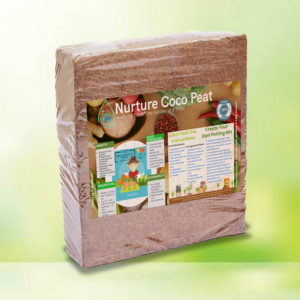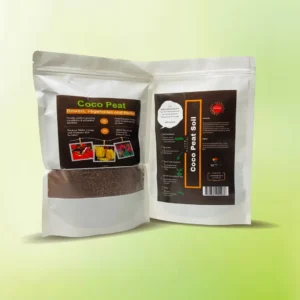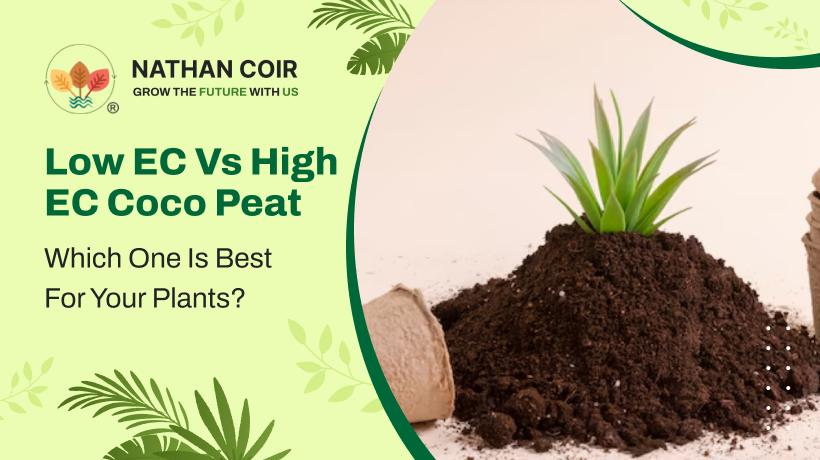Coco peat’s superior water retention and aeration qualities make it a popular growing medium in hydroponics, gardening, and agriculture. But not all coco peat is created equal. Electrical Conductivity (EC) is one of the key characteristics that distinguish different kinds of coco peat. The salt concentration of coco peat, which is dictated by the EC level, has a direct effect on plant growth. This page will discuss low and high EC cocopeat’s distinctions, applications, and how to choose the appropriate type for your needs.
At Nathan Coir, we offer premium-quality low EC coco peat to meet the diverse needs of gardeners and farmers.
What is EC in Coco Peat?
EC stands for Electrical Conductivity, a measure of the salt content in a growing medium. It determines how well the material can conduct electricity, which is directly related to the concentration of dissolved salts. The higher the EC, the more salts are present.
Why is EC Important?
Impacts Plant Growth: Too much salt in coco peat can harm roots and lead to nitrogen imbalances, which can impede plant growth.
Establishes Suitability: EC values vary depending on the plant. While some can withstand high EC levels, others do best in low EC environments.
Indicates Processing Level: High EC coco peat is less washed and retains more natural salts, whereas low EC coco peat undergoes multiple washing cycles to reduce salt content.
Low EC Coco Peat
What is Low EC Coco Peat?
Low EC coco peat is ideal for a variety of plants since it has been repeatedly cleaned to eliminate excess salts. With an EC level typically below 0.5 mS/cm, it guarantees a nutrient-rich environment for plant roots.
Benefits of Low EC Coco Peat
Perfect for Seed Germination: Young seedlings won’t be harmed by too many minerals thanks to the lower salt concentration.
Perfect for Hydroponics: Since hydroponic systems rely on controlled nutrient levels, low EC coco peat prevents salt build-up.
Better for Sensitive Plants: Plants like vegetables, flowers, and herbs thrive in cocopeat block low EC.
Enhances Root Growth: With minimal salt interference, roots can absorb nutrients efficiently.
The finest growing conditions for your plants are guaranteed by the premium low EC coco peat that Nathan Coir offers.
Top Uses for Low EC Coco Peat in Soilless and Hydroponic Growing
- Hydroponics and soilless growing
- Potting mixes and container gardening
- Commercial farming and nursery plants
High EC Coco Peat
What is High EC Coco Peat?
Natural salts are more prevalent in high EC coco peat, which typically has an EC level more than 1.0 mS/cm. It is appropriate for some agricultural applications since it is less cleansed or unclean.
Benefits of High EC Coco Peat
Good for Salt-Tolerant Plants: Some plants, such as coconut palms and certain ornamentals, can thrive in high EC environments.
Cost-Effective for Bulk Use: Since it undergoes less processing, it is usually more affordable.
Used for Soil Amendment: High EC coco peat can improve soil aeration and water retention in farming.
Best Applications of High EC Coco Peat
- Used in fields where natural leaching can occur
- Soil conditioning in agriculture
- Growing salt-resistant crops
Key Differences Between Low EC & High EC Coco Peat
The table below summarizes the main differences:
| Feature | Low EC Coco Peat | High EC Coco Peat |
| EC Level | Less than 0.5 mS/cm | More than 1.0 mS/cm |
| Processing | Washed One time | Less washed or unwashed |
| Salt Content | Low | High |
| Best for | Hydroponics, seedlings, sensitive plants | Soil amendment, salt-tolerant plants |
| Cost | Higher due to washing process | Lower due to minimal processing |
| Usage | Potting mix, commercial farming, home gardening | Agricultural soil enhancement |
How to Choose the Right Coco Peat for Your Needs
Factors to Consider
- Type of Plants You’re Growing: If you’re growing vegetables, herbs, or flowers, low EC cocopeat is the best choice. If you need it for large-scale farming, high EC coco peat might be more economical.
- Growing Method: Hydroponics and seed starting require cocopeat block low EC, while field farming can work with high EC coco peat.
- Budget: Low EC coco peat is slightly more expensive due to the washing process, but it provides better results for sensitive plants.
Where to Buy Quality Low EC & High EC Coco Peat?
Nathan Coir – Your Trusted Coco Peat Supplier
At Nathan Coir, we offer top-quality low EC coco peat that meets industry standards. Our coco peat is processed with advanced washing and drying techniques to ensure premium quality for all agricultural and gardening needs.
Why Choose Nathan Coir?
- Guaranteed Quality: We provide thoroughly tested and high-quality coco peat.
- Affordable Prices: Get the best deals on cocopeat block low EC.
- Bulk & Retail Options: We cater to both large-scale agricultural farms and small gardening projects.
- Reliable Shipping: We deliver across various locations, ensuring timely delivery.
Conclusion
Choosing the right coco peat depends on your specific growing needs. Low EC cocopeat is ideal for delicate plants, hydroponics, and commercial gardening, whereas high EC coco peat is more suited for agricultural soil enhancement and salt-tolerant crops. Understanding the difference between low EC and high EC cocopeat ensures that you select the best option for your plants and growing conditions.
For premium low EC coco peat, trust Nathan Coir – your reliable supplier for high-quality coco peat products. Contact us today to get the best coco peat for your gardening and farming needs!




